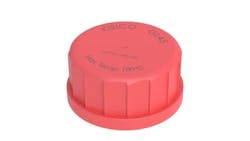Packaging specialist Kisico (Oestrich-Winkel, Germany) and science and technology company Merck (Darmstadt, Germany) have partnered to develop a bottle cap featuring Merck Iriotec 8000 series laser pigments at the upcoming Fachpack trade fair (Nuremberg, Germany). These pigments yield optimum results for laser marking.
The principle of laser marking plastics is an established labeling process that has been used for years, for example, in the beverage industry. Kisico can supply the caps with any requested laser marking. For laboratory caps, important information such as manufacturer, brand and product names, or batch number can be laser-marked on the cap. Contents are easier to identify and mix-ups are avoided as a result. However, other information can also be marked such as thread size, temperature resistance, or hazard symbols. The entire surface can be used for the labeling—customers are not limited to the top plate. And switching to laser marking eliminates costs for changes to the injection molding tool, embossed stamp, or printing plates.
This vital labeling of caps is offered by Kisico as part of an expanded service package. Alternatively, customers with the appropriate equipment can perform the laser marking directly in-house, for example, on the filling line. This means a substantial increase in flexibility when it comes to labeling. Each cap can be quickly and permanently marked with the batch number or a data matrix code, which translates into significant advantages in traceability. With laser marking, very fine markings are possible even on small surfaces, which means that a great deal of information can be included.
All caps from the Kisico product range can be provided with this high-performance pigment from Merck.
Since lasers write using only light, no additional materials are required during the marking process besides electricity and fume exhaust. The caps also do not need to be pretreated. Products such as inks and solvents are superfluous, smudging does not occur, and drying is unnecessary. Downtimes for cleaning and setup are eliminated. Experiences from the food and cosmetics industries have shown that maintenance costs are reduced to a minimum as a result.
For more information, please visit www.kisico.de and www.merckgroup.com.
